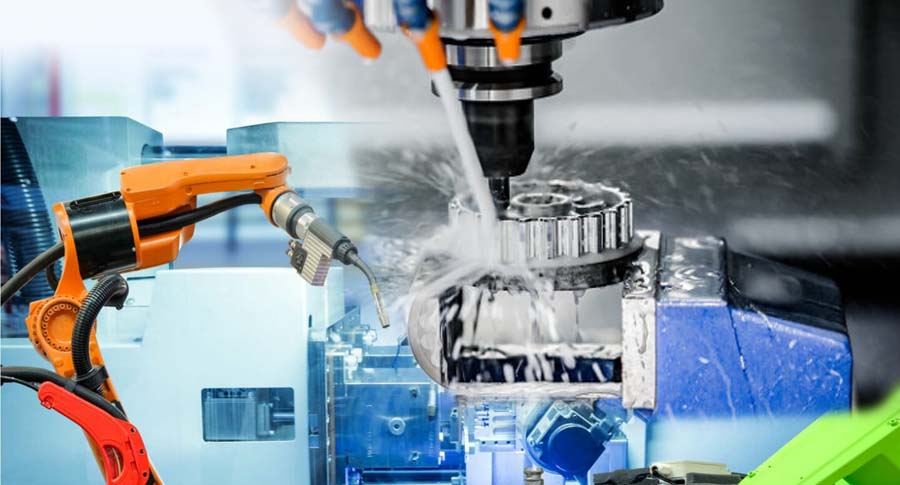With the advancement of technology and the growth of market demand, the robotics industry will continue to maintain rapid development. The arrival of an aging society and the rise in labor costs have led to an increasing demand for robots in various industries, and the future prospects of the robotics industry are very broad.
CNC precision parts machining has become a cornerstone in the manufacturing of robot parts, offering a host of advantages that make it an ideal choice for this high-tech industry. Here, we explore the benefits and applications of CNC machining in robot parts manufacturing.
Advantages of CNC Precision Parts Machining in Robotics
High Precision and Accuracy
Tight Tolerances: CNC machines are capable of producing parts with extremely tight tolerances, which is crucial for the intricate and precise components required in robotics.
Repeatability: CNC machining ensures that each part is produced with the same level of accuracy, maintaining consistency across multiple units.
Complex Geometries
Multi-Axis Machining: CNC machines can operate on multiple axes simultaneously, allowing for the creation of complex geometries that would be difficult or impossible to achieve with traditional machining methods.
Intricate Details: The ability to precisely control the machining process allows for the creation of intricate details, essential for the functionality of robot parts.
Material Versatility
Wide Range of Materials: CNC machining is compatible with a broad spectrum of materials, including metals (aluminum, steel, titanium) and plastics (ABS, polycarbonate). This versatility is beneficial for creating various robot components with different material properties.
Material Properties: The choice of materials allows for optimization of weight, strength, and durability, catering to the specific needs of different robotic applications.
Efficiency and Speed
Automated Processes: CNC machines operate autonomously once programmed, reducing the need for manual intervention and increasing production speed.
Quick Turnaround: CNC machining can produce parts rapidly, making it suitable for both prototyping and full-scale production runs.
Cost-Effective Production
Reduced Waste: Precision machining minimizes material waste, making the process more cost-effective.
Lower Labor Costs: Automation reduces the need for skilled labor, further decreasing production costs.

Applications of CNC Precision Parts Machining in Robotics
Robotic Arms
Joint Components: CNC machining is used to manufacture precise joint components that enable smooth and accurate movement of robotic arms.
Actuators and Sensors: The production of actuators and sensor housings requires high precision to ensure proper functionality and integration.
End Effectors
Grippers and Tools: End effectors, such as grippers and specialized tools, need to be tailored to specific tasks. CNC machining allows for the customization and precision necessary for these components.
Interchangeable Parts: The ability to produce interchangeable end effectors enables robots to perform a variety of tasks, enhancing their versatility.
Structural Frames
Chassis and Framework: The structural integrity of robots depends on precisely machined frames and chassis, which CNC machining can provide.
Lightweight Components: CNC machining allows for the creation of lightweight yet strong components, crucial for mobile robots and drones.
Gearboxes and Transmission Systems
Gears and Bearings: High-precision gears and bearings are essential for the efficient transmission of power within robotic systems.
Transmission Housings: CNC machining produces robust housings that protect transmission systems and ensure their reliability.
Electronic Housings
PCB Enclosures: The delicate nature of electronic components in robots necessitates precise housings to protect them from environmental factors and mechanical stress.
Heat Sinks: CNC machining is used to produce heat sinks that manage the thermal load in electronic systems, ensuring optimal performance.
Case Examples
Industrial Robots
Industrial robots require highly precise motion control. The high-precision joints, bearings, and gears processed by CNC can ensure the efficient and stable operation of robots on automated production lines.
Service Robots
Service robots, such as household robots and medical robots, require flexible joints and high-precision sensors. CNC machining can manufacture lightweight and high-precision components to meet the special needs of these robots.
Medical Robots
Medical robots require extremely high precision and reliability, especially in surgical robots. CNC machining can produce high-precision components that meet medical standards, ensuring the safety and effectiveness of surgery.
Conclusion
CNC precision part machining plays an irreplaceable role in robot component manufacturing, with high precision, high consistency, and complex shape machining capabilities that can meet various strict requirements of robot components. Whether it is industrial robots, service robots, or medical robots, CNC machining can provide reliable solutions that support the high performance and reliability of robots.
As robotics continues to advance, CNC machining will remain a key technology, driving innovation and enhancing the capabilities of robotic systems.



